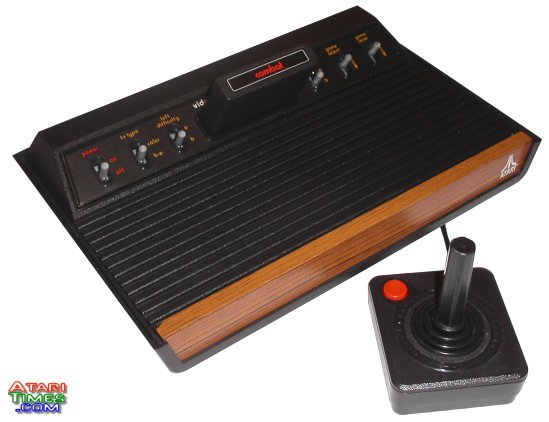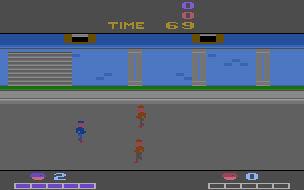 |
 |
Antique Electric Dreams |
 With
hardware reaching 30 years old the Atari VCS is the most
important console ever released. Finally bringing
computer technology into the homes of millions, Atari
created an industry only to lose it six years later. And
while the console saw official software releases all the
way to the early 1990's, the machine continues to be
supported by the fan and hobbyist communities in both
software and hardware fronts. The majority of this group
were the children who received a brand new Atari as a
child or teen during the late 1970's early 1980's and
have wonderful nostalgic memories of the machine.
With
hardware reaching 30 years old the Atari VCS is the most
important console ever released. Finally bringing
computer technology into the homes of millions, Atari
created an industry only to lose it six years later. And
while the console saw official software releases all the
way to the early 1990's, the machine continues to be
supported by the fan and hobbyist communities in both
software and hardware fronts. The majority of this group
were the children who received a brand new Atari as a
child or teen during the late 1970's early 1980's and
have wonderful nostalgic memories of the machine.
By by the late 1990's just before the retroputing pop culture boom, there were already fans of the once console monarch who were much too young to have experienced the joys of the system in its heyday. One of these people is the writer of this very article. And so if not the nostalgia factor, there exists other reasons for its following.
The system compared to today's consoles is clunky, slow, simple and frankly an electronic antique. And so for those who are fans of cutting edge technology, without nostalgia there is nothing obviously alluring to the mind. And so you are presented with the charms of yesteryear that cause appeal to the mindful individuals too few in years.
 Beginning
with the humble controller. The classic one button, eight direction digital
joystick design offers simplistic control and arcade feel, the alternative
is the paddle controller, again a one button device, analogue control is
brought to the users hands with a large knobbed potentiometer, allowing
precise control at your fingertips. The singular button interface does not
allow for highly complex control schemes but this was worked around with the
use of two controllers, or simple keypad controllers. Thus, games are all
simple to learn and do not require tutorials to get the basic hang of use.
Beginning
with the humble controller. The classic one button, eight direction digital
joystick design offers simplistic control and arcade feel, the alternative
is the paddle controller, again a one button device, analogue control is
brought to the users hands with a large knobbed potentiometer, allowing
precise control at your fingertips. The singular button interface does not
allow for highly complex control schemes but this was worked around with the
use of two controllers, or simple keypad controllers. Thus, games are all
simple to learn and do not require tutorials to get the basic hang of use.
The medium used by the 2600 is the ROM cartridge, a silicon chip encased in a PCB and plastic housing. Its basic shape allows the cartridge manufacturer in this case Atari, to feature classic artworks to inspire the imagination of the user. The pure durability of the cartridge in its solid state form has great appeal to a society that has a growing community using optical media as the personal storage option of choice. With cartridges the fear of media destruction is low.
 Atari's
Video Computer System itself was based of the 6507 chip, a low cost 6502
reduction further limited by RAM and ROM costs of the late 1970's. While the
machine upon release was very modern and practically bleeding edge, within a
year or two, microprocessor technology began its great boom and the system
had begun its journey of being technologically left behind. Placed in
durable thick plastic the VCS is the most solid home console ever released.
Atari's
Video Computer System itself was based of the 6507 chip, a low cost 6502
reduction further limited by RAM and ROM costs of the late 1970's. While the
machine upon release was very modern and practically bleeding edge, within a
year or two, microprocessor technology began its great boom and the system
had begun its journey of being technologically left behind. Placed in
durable thick plastic the VCS is the most solid home console ever released.
Both the cartridge format and the system itself will have an unknown but highly projected life expectancy unlike their modern counterparts.
 The
software for the console is the most intriguing piece in the 2600 puzzle.
From the early releases of Video Olympics, Night Driver, Adventure
and the venerable pack-in Combat, to the late releases (laughably
competing with the likes of the Sega Genesis and the Super Nintendo
Entertainment System) like Solaris, BMX Airmaster, Double Dunk, and
Secret Quest, each game was simple to operate and featured something new
out of the console. The first games had the programmers exploring the VCS
and the late games pushed it to obscene limits featuring all types of
incredible tricks. The VCS inspires many for idea that the system was able
to continue to produce games far beyond what it was originally designed for,
much to Atari's economic benefit.
The
software for the console is the most intriguing piece in the 2600 puzzle.
From the early releases of Video Olympics, Night Driver, Adventure
and the venerable pack-in Combat, to the late releases (laughably
competing with the likes of the Sega Genesis and the Super Nintendo
Entertainment System) like Solaris, BMX Airmaster, Double Dunk, and
Secret Quest, each game was simple to operate and featured something new
out of the console. The first games had the programmers exploring the VCS
and the late games pushed it to obscene limits featuring all types of
incredible tricks. The VCS inspires many for idea that the system was able
to continue to produce games far beyond what it was originally designed for,
much to Atari's economic benefit.
And with modern day releases using new and fascinating advances to push
the 2600 even further the interest can only grow in its age.
| Name: | |
| Subject: | |
| Comment: | |
| Check: | What is the greatest video game company of all time? (Hint: Atari.) |